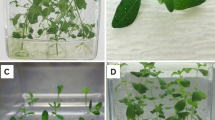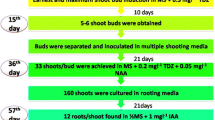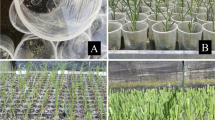Abstract
The production of new varieties and higher quality products from Echinacea spp. requires a greater understanding of the regulation of plant growth and the production of specific phytometabolites. The current studies were designed to generate elite varieties of Echinacea purpurea based on regeneration efficiency and chemical profile. Clonal propagation of seedling-derived regenerants and screening for antioxidant potential and concentrations of caftaric acid, chlorogenic acid, cichoric acid, cynarin, and echinacoside identified 58 unique germplasm lines. Chemical profiles varied significantly among germplasm lines but were consistent within clones of each line. In temporary immersion bioreactors, exogenous application of the auxin indolebutyric acid significantly increased the cichoric acid and caftaric acid concentration in the root tissues. Together, these demonstrate the potential for selective breeding of elite, highly regenerative, chemically superior, clonally propagated varieties from the naturally occurring genetic variability in the seed populations of E. purpurea.










Similar content being viewed by others
References
Barnes PM, Powell-Griner E, McFann K, Nahin RL (2004) Complementary and alternative medicine use among adults: United States, 2002. Adv Data 27(343):1–19
Bergeron C, Livesey JF, Awang DVC, Arnason JT, Rana J, Baum BR, Letchamo W (2000) A quantitative HPLC method for the quality assurance of Echinacea products on the North American market. Phytochem Anal 11(4):207–215
Binns SE, Baum BR, Arnason JT (2002a) A taxonomic revision of Echinacea (Asteraceae: Heliantheae). Syst Bot 27(3):610–632
Binns SE, Arnason JT, Baum BR (2002b) Phytochemical variation within populations of Echinacea angustifolia (Asteraceae). Biochem Syst Ecol 30(9):837–854
Binns SE, Livesey JF, Arnason JT, Baum BR (2002c) Phytochemical variation in Echinacea from roots and flowerheads of wild and cultivated populations. J Agric Food Chem 50(13):3673–3687
Blumenthal M (2003) The ABC Clinical Guide to Herbs. American Botanical Council. Thieme, New York, ISBN 1-58890-157-2
Brand-Williams W, Cuvelier ME, Berset C (1995) Use of a free radical method to evaluate antioxidant activity. Lebensm–Wiss Technol 28:25–30
Cheminat A, Zawatzky R, Becker H, Brouillard R (1988) Caffeoyl conjugates from Echinacea species: structures and biological activity. Phytochem 27(9):2787–2794
Choffe KL, Victor JMR, Murch SJ, Saxena PK (2000). In vitro regeneration of Echinacea purpurea L: Direct Somatic Embryogenesis and Indirect shoot organogenesis in petiole culture. In Vitro Cell Dev Biology-Plant 36:30–36
Coker PS, Camper ND (2000) In vitro culture of Echinacea purpurea L. J Herbs Spices Med Plants 7:1–7
Dutta Gupta S, Datta S (2003) Antioxidant enzyme activities during in vitro morphogenesisof gladiolus and the effect of application of antioxidants on plant regeneration. Biologia Plantarium 47(2):179–183
Gamborg OL, Miller RA, Ojima K (1968) Nutrient requirement of suspension cultures of soybean root cells. Exp Cell Res 50:150–158
Kairong C, Gengsheng X, Xinmin L,Gemgmei X, Yafy W (1999). Effect of hydrogen peroxide on somatic embryogenesis of Lycium barbarum L. Plant Sci 146:9–16
Konig B, Dustmann JH (1985) The caffeoylics as a new family of natural antiviral compounds. Naturwissenschaften 72(12):659–661
Koroch A, Kapteyn J, Juliani HR, Simon JE (2002a) In vitro regeneration and agrobacterium transformation of Echinacea purpurea leaf explants. In: Janick J, Whipkey A (eds) Trends in new crops and uses. ASHS Press, Alexandria, VA. pp 522–526
Koroch A, Juliani HR, Kapteyn J, Simon JE (2002b) In vitro regeneration of Echinacea purpurea from leaf explants. Plant Cell Tiss Org Cult 69:79–83
Mechanda SM, Baum BR, Johnson DA, Arnason JT (2003) Direct shoot regeneration from leaf segments of mature plants of Echinacea purpurea L. Moench. In Vitro Cell Dev Biol 39:505–509
Murashige T, Skoog F (1962) A revised medium for rapid growth and bioassays with tobacco tissue cultures. Physiol Plant 15:473–497
Murch SJ, KrishnaRaj S, Saxena PK (2000a) Phytopharmaceuticals:Mass-Production, Standardization and Conservation. Sci Rev Alternate Med 4:39–43
Murch SJ, KrishnaRaj S, Saxena PK (2000b) Phytopharmaceuticals: Problems, Limitations and Solutions. Sci Rev Alternate Med 4:33–38
Pan ZG, Liu CZ, Zobayed SMA, Saxena PK (2004) Plant regeneration from mesophyll protoplasts of Echinacea purpurea. Plant cell Tiss Org Cult 77:251–255
Perry EB, Burgess EJ, Glennie VL (2001) Echinacea standardization: nalytical methods for phenolic compounds and typical levels in medicinal species. J Agric Food Chem 49(4):1702–1706
Wang H-M, To K-Y (2004) Agrobacterium mediated transformation in the high-value medicinal plant Echinacea purpurea. Plant Sci 166:1087–1096
Zobayed SMA, Saxena PK (2003) In vitro regeneration of Echinacea purpurea L.: Enhancement of somatic embryogenesis by indolebutyric acid and dark pre-incubation. In Vitro Cell Dev Biol 39:605–612
Acknowledgements
The financial support of the Natural Sciences and Engineering Counsel of Canada and Science-Based Medicinal Plants is gratefully acknowledged.
Author information
Authors and Affiliations
Corresponding author
Additional information
Communicated by G. C. Phillips
Rights and permissions
About this article
Cite this article
Murch, S.J., Peiris, S.E., Shi, W.L. et al. Genetic diversity in seed populations of Echinacea purpurea controls the capacity for regeneration, route of morphogenesis and phytochemical composition. Plant Cell Rep 25, 522–532 (2006). https://doi.org/10.1007/s00299-006-0118-5
Received:
Revised:
Accepted:
Published:
Issue Date:
DOI: https://doi.org/10.1007/s00299-006-0118-5




